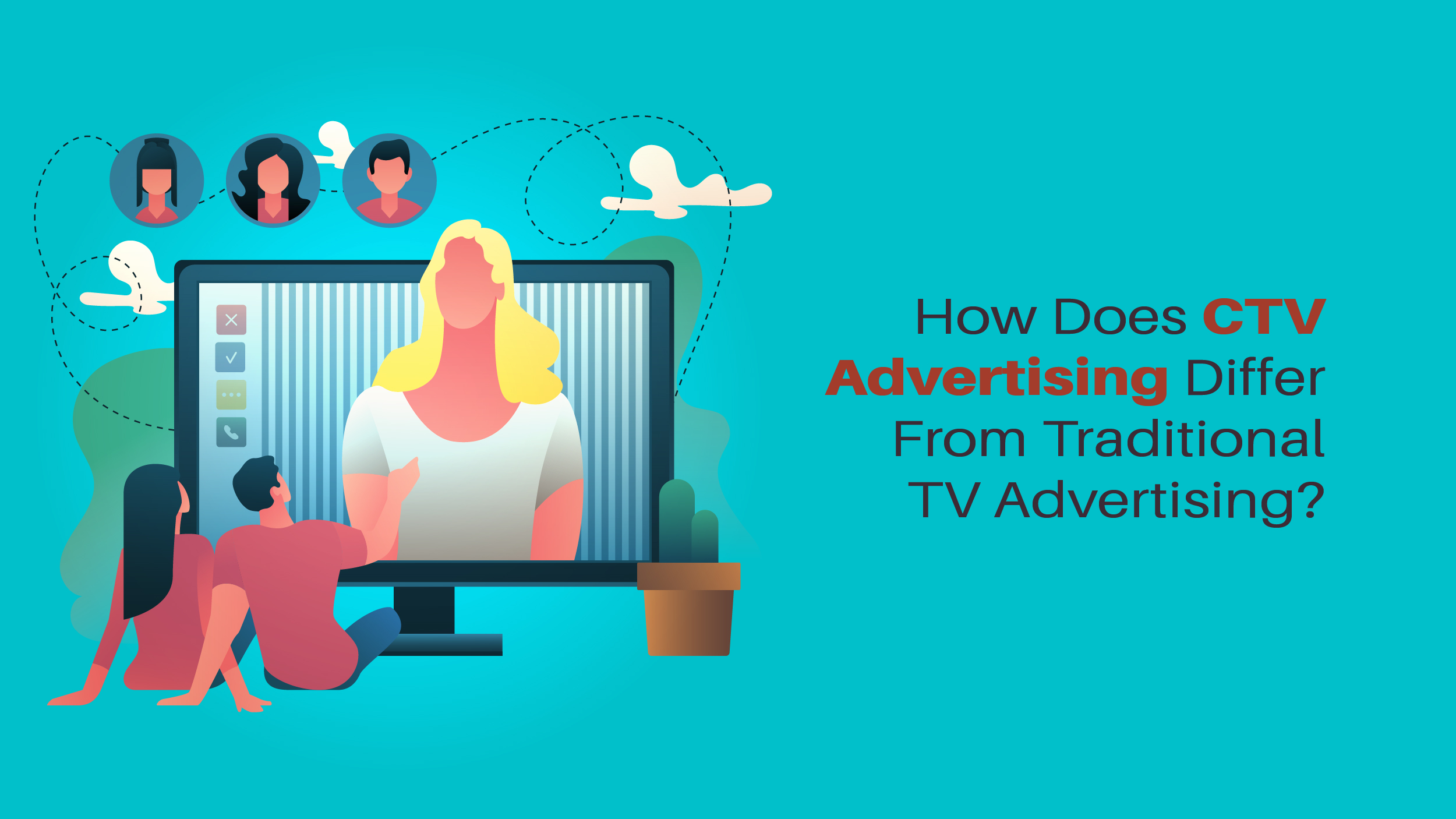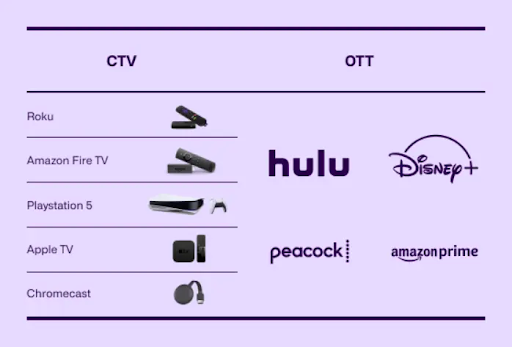Have you ever come across advertisements on streaming platforms like Apple TV or Roku? That is a simple example of CTV advertising. In a nutshell, connected TV advertisements are ads that show up on streaming devices (smart TVs, Amazon Firestick, etc.).
You might be wondering what this has to do with marketing. Well, quite a lot.
According to eMarketer, CTV ad spending will reach over $30 billion in 2024, up 22.4% from $24.6 billion in 2023. This means a 22.4% hike in the opportunity to get your ad in front of your ideal audience.
This article discusses everything you need to know about CTV advertising.
What is CTV Advertising?
Digital advertising that is displayed within streaming media is known as CTV advertising. It includes, for instance, advertisements displayed next to TV shows or live streams watched on streaming devices. Interactive advertisements are an additional example. These are targeted advertisements that foster interactions with the audience. Online video (OLV) and in-stream advertisements are two more types of video commercials appearing within online video content.
Audiences are watching their favorite shows using numerous streaming devices and services; hence, it becomes essential for marketers to connect with these consumers. CTV advertising can help with this tremendously.
GroupM’s research shows that the revenue companies spend on CTV ads is rapidly growing. They expect a 13.8% increase in 2024. 62% of these companies shifted their budgets from digital, social media, or regular TV advertisements to connected TV advertising.
Benefits of Connected TV Advertising
 Brands may connect with consumers already consuming content by using CTV advertising. This type of digital advertising can target audiences that are watching content across websites and videos, in addition to customers who shop in physical or virtual retailers. Advertisers and vendors could increase the reach of their brands by taking these viewers into account.
Brands may connect with consumers already consuming content by using CTV advertising. This type of digital advertising can target audiences that are watching content across websites and videos, in addition to customers who shop in physical or virtual retailers. Advertisers and vendors could increase the reach of their brands by taking these viewers into account.
Advertisers looking to attract cord-cutters and cord-nevers who stream their entertainment instead of watching linear TV can benefit from CTV video advertising. The advertisement may appear in various formats, including premium TV series, news video streaming applications, and online Twitch livestreams.
How Does CTV Advertising Differ From Traditional TV Advertising?
 Connected TV ads differ from normal TV ads in various ways:
Connected TV ads differ from normal TV ads in various ways:
- Viewership: CTV advertising targets viewers who moved away from traditional cable services, consuming videos via web-enabled devices like smart TVs, streamers, and gaming consoles. This audience includes cord-cutters and younger individuals missed by conventional TV promotions.
- Adaptability: CTV ads offer greater placement and timing flexibility, plus the chance to customize ads across platforms and devices. Advertisers can pinpoint their target audience with the right messages at the optimal moment.
- Quantifiable Results: CTV advertising yields measurable outcomes, letting advertisers track ad performance and make data-backed decisions. This streamlines campaign optimization and improves return on investment.
- Targeting Prowess: CTV ads enable precise targeting based on viewer demographics, interests, and watching habits. TV adverts let companies target certain viewers. They show ads likely to interest that group.
- Reach: Businesses may reach a wide audience with CTV ad, including those who favor free ad-supported streaming services and cord-cutters. The possible reach of CTV advertising is substantial given the popularity of streaming services.
- Interactivity: Compared to traditional TV advertisements, CTV ads can be more interactive and offer a better customer experience.
What is CTV vs OTT?
OTT and CTV, though used interchangeably, are distinct concepts. OTT refers to video delivery across devices like mobile and desktop via the internet. Conversely, CTV only streams onto smart TVs, earning it the moniker “streaming TV advertising.” OTT means “over-the-top” content transmitted without cable or satellite, accessing TV via the internet instead.
“Over-the-top,” or “OTT,” refers to material that streams TV shows “over” your cable box and into your internet browser rather than through a cable or satellite receiver.
The inventory of OTT advertising can differ significantly from that of connected TVs. While OTT includes a far larger spectrum of content, connected TV typically refers to premium network content that looks like what you would watch on traditional television.
 How Does CTV Advertising Work?
How Does CTV Advertising Work?
Marketers work with content distributors to publish their ads in streaming content, provided by CTV advertising platforms like Hulu, Peacock, Pluto TV, Tubi, etc.
These ads can reach a massive audience, as many as 100 million viewers. The best part is that advertisers can tailor their message based on viewing behavior, preferences, interests, and demographics, or even segment audiences with relevant content.
The process of how ads end up on viewers’ screens involves several steps, often beginning with a programmatic ad approach. It refers to the automated buying and selling of ad space in real-time through a bidding process. First marketers check with content providers for inventory availability, followed by ad placement, real-time bidding, ad serving, and targeting & personalization.
Several formats for CTV ads exist. Some run alongside TV shows or live streams, while others are interactive ads or in-stream ads. Online video ads on websites also count. These ads are further displayed on various CTV devices. Also, the process for purchasing and executing CTV campaigns differs per platform or service used.
How to Buy CTV Advertising?
Kickstarting a successful CTV strategy begins with identifying your goals and selecting the right platforms. Think about who your target market is, the action you want them to take, how it blends with your other marketing efforts and the resources you need. Your choices could include things like smart TV manufacturers, streaming devices, video streaming services, or demand-side providers as well.
After you’ve picked a platform, assess its capacity for accurate targeting, collecting data, and making in-campaign adjustments. Select an ad format; it could be 15 or 30-second teasers, quick 6-second snaps, or introduce interactive features like QR codes. Pinpoint your target audience and deliver ads via digital targeting technology.
Share your data directly with the publisher or buy third-party data from companies. Roll out your ads through the selected platform, zeroing in on your intended audience. Monitor and fine-tune parameters like location attribution, website attribution, and conversions, uplifts in online and offline sales, and foot traffic.
Real-time applications can help shift the budget to well-performing channels mid-campaign. In summary, a meticulously planned CTV campaign necessitates thoughtful platform selection, a well-defined audience, performance tracking, and refinement, supplemented with budgeting tools that work in real-time.
Also Read: Programmatic Display Advertising- What is It and Why is it Important?
CTV Metrics and Measurement
Since the digital ad channel is the core of Connected TV, it uses traditional metrics of digital marketing and KPIs as ways to determine how well it performs. Below are a few important metrics for measuring the success of CTV advertising.
Impressions:
This helps you understand your campaign’s scale across TV screens as the ads are served out.
Return on Ad Spend (ROAS):
A performance metric, return on ad spend (ROAS) shows you how much revenue has been generated by your campaign compared to the overall amount you have spent on advertising. The higher the ROAS the better – this means that your CTV campaign has returned many times more than its cost of sending out.
Cost per Completed View:
This is simply a measure of how expensive it is to get someone to finish watching an ad. It tells us what portion of a campaign’s budget is being burned up by each completed view. How does one know if a view has “completed”? For the most part, this means that someone watched an entire commercial from start to end. Yet sometimes some CTV ad platforms may record any sight that goes beyond 10 seconds as complete.
Cost per Acquisition (CPA)
Similar to ROAS, CPA tells the campaign cost for an acquisition sale, form signup, or intended “acquisition” action. A lower CPA indicates higher efficiency in capturing acquisitions.
Reach
Reach refers to the unique individuals exposed to your Connected TV advertisement. It is often displayed as a percentage of a specific audience demographic; for instance, 75% of 18-24 year-olds. Reach indicates the targeted population percentage that has viewed at least one traditional or CTV ad.
Frequency
Delivering one million impressions does not necessarily mean one million unique viewers saw your advertisement. Frequency is the average number of times an ad is delivered to a given person. Knowing frequency prevents repeated ad serving to the same individual. If 3,000 ads reach 1,000 unique people (your reach), the frequency is three.
GRP (Gross Rating Point)
GRPs predate the internet era. They determine the target audience percentage that viewed an ad. For example, targeting 18-34-year-old males, 30% watch a specific Sunday night sports game. Purchasing four commercial spots during the broadcast reaches 30% of the target audience approximately four times each, resulting in a GRP of 120.
CPP (Cost Per Point)
CPP is important for ads. It shows how well ads reach your target audience for the cost. First, get your GRP (Gross Rating Point). Then, divide your total media cost by GRP. The result is your CPP what you pay per rating point.
Cross-Screen Measurement
This metric lets you track video metrics across devices. Mobile, TV, outdoor, Connected TV and desktop you can measure on all these screens. Users don’t just view one device, so cross-screen measurement is handy.
Target Rating Point
Target rating point shows the percentage of your desired audience who see your ads. Your target audience is key the customers most likely to buy your products/services. Knowing your target rating point helps make CTV ad targeting campaigns successful.
How Much Does CTV Advertising Cost?
CTV ads cost $20 to $50 for every thousand impressions. Their CPM is affected by things like inventory type and location targeting. Typically, CTV ad CPMs fall between $35 and $65. YouTube video CPMs are $20 to $25 on average. While CTV ad costs per thousand views can reach mid-double-digits, programmatic campaigns only charge for played ads during set timeframes, improving cost efficiency.
What are the Challenges Faced by CTV Advertising?
Like any other method, CTV ads also face certain challenges.
- Fragmentation: The CTV market is disjointed, with different services, devices, and platforms. This fragmentation makes it hard for media buyers. They struggle to manage ad campaigns across multiple environments. They also can’t measure audiences consistently.
- Measuring Metrics: Measuring CTV ads is complex. Common indicators and standards are lacking. Different CTV players use varying methods. Getting performance data across sources is tricky. Device and data fragmentation also complicate measurement efforts.
- Transparency Issues: CTV ads lack transparency on show-level details. Advertisers and publishers can’t allocate budgets effectively. They need insights into the content and streaming videos showing their ads. This helps avoid low-quality or non-professional placements.
- Lack of Omnichannel strategies: CTV advertising needs integration with omnichannel strategies. It should align with digital planning, buying, measurement, and attribution. The disconnect between CTV and the omnichannel picture challenges advertisers. They seek a cohesive strategy across channels.
- Ad Fraud: CTV advertising is vulnerable to ad fraud, similar to other programmatic markets. Compared to other channels, CTV platforms exhibit lower rates of ad fraud. However, the lack of ad quality regulations and standards makes them susceptible to schemes impacting the profits of industry players.
Establishing common measurement standards, enhancing transparency, integrating CTV within omnichannel strategies, and implementing measures against ad fraud are necessary steps to overcome these challenges.
Final Thoughts
Through internet-linked television devices, advertisers may now interact with their target audience in a new and dynamic way with connected TV ads. Advertisers can develop successful campaigns that reach the right audience at the right time with customized messaging and accomplish their marketing goals by utilizing the advantages of CTV advertising.


Comments are closed.